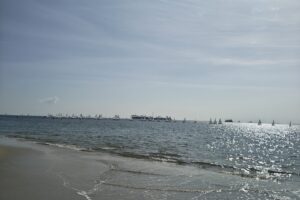Building Breakwalls
Building a breakwater wall to protect a beach is a topic that often sparks debate among environmentalists, beachgoers, and coastal engineers. Usually built offshore, this solid structure is designed to protect the shoreline from erosion by breaking the force of incoming waves before they reach the shore. But is it a foolproof solution, or does it come with hidden consequences? Let’s dive into the pros and cons of breakwalls to see if they’re genuinely a savior for our coastlines—or if they create more challenges than they solve.
The Pros of Building a Breakwall
- Protection Against Erosion One of the primary reasons for building a breakwall is to combat erosion. Waves constantly battering the shoreline can wear down the beach, eroding the sand and making it disappear over time. A breakwall helps to slow down this process by breaking up the wave energy before it reaches the beach, essentially giving the sand a “buffer zone.” For areas where beach erosion is a significant issue, breakwalls can provide much-needed relief.
- Preserving Infrastructure Near the beach, coastal towns and cities often have vital infrastructure—roads, boardwalks, homes, and businesses. These structures could be at risk without protection as waves gradually eat away at the coastline. Breakwalls act as a shield, protecting these assets from being destroyed by high waves or storm surges. For communities that rely on beach tourism or have properties at risk of flooding, breakwalls can be a valuable investment.
- Encouraging Beach Use With a breakwall in place, the beach becomes more accessible and enjoyable. The calmer waters created by the breakwall make the beach more suitable for recreational activities like swimming and paddleboarding, as the waves are less intense. Additionally, reduced erosion can mean a broader, more stable beach—making it a more excellent place to set up a picnic or sunbathe without worrying about disappearing shorelines.
- Potential Habitat Creation In some cases, breakwalls can encourage the growth of specific marine habitats by providing a stable structure for sea life to latch onto. Coral, seaweed, and other underwater organisms sometimes use breakwalls as artificial reefs, which can attract fish and other marine creatures. This can enhance local biodiversity if the conditions are right.
The Cons of Building a Breakwall
- Environmental Impact While breakwalls can create new habitats, they can also disrupt existing ecosystems. Many marine species rely on the natural ebb and flow of the tides and the sand movement along the shore. By altering wave patterns, breakwalls can disturb these natural systems. This could impact wildlife, including fish, crabs, and birds, which depend on the beach for food and breeding grounds.
- Shifting Erosion Elsewhere While breakwalls can protect one part of the beach, they may unintentionally increase erosion down the coast. When waves hit the breakwall, they’re redirected, and this energy needs to go somewhere. Often, this means that beaches further along the coast experience increased erosion. So, while a breakwall might be effective locally, it can create more significant erosion issues elsewhere, impacting other beaches or coastal communities.
- High Maintenance Costs Building a breakwall is no small task. It requires a lot of materials, engineering, and planning. Once built, breakwalls aren’t maintenance-free. Over time, they need to be checked and reinforced, especially after storms or severe weather. This ongoing maintenance can be costly for local governments and, indirectly, taxpayers. Communities need to consider if the long-term benefits outweigh the expense.
- Aesthetic Impact Let’s face it—when people visit a beach, they expect to see natural landscapes, not concrete walls sticking out of the water. Breakwalls can be visually intrusive, especially if they’re large structures. They can change the character of a beach, making it feel less natural and more industrial. For some communities that rely on the beach for tourism, a breakwall could actually detract from the natural beauty that draws visitors in the first place.
- Increased Beach Crowding When a breakwall reduces wave action, it can increase beach usage. While this might sound positive, it can also mean overcrowded beaches, particularly during peak seasons. The calm, sheltered waters created by a breakwall may attract more swimmers, leading to busier shorelines and potential overuse of the area.
The Bottom Line
Building a breakwall to protect a beach isn’t a one-size-fits-all solution. It can provide essential protection against erosion, help preserve coastal infrastructure, and make the beach more user-friendly. However, the environmental impact, high costs, and potential for increased erosion in neighboring areas are important considerations. Understanding the unique needs and environmental conditions of your local area, such as the frequency and severity of storms, the presence of endangered species, or the importance of the beach for tourism, is crucial when considering a breakwall.
Ultimately, each coastal community must weigh the pros and cons of a breakwall based on its unique needs and environmental conditions. Alternative solutions, like beach nourishment or dune restoration, may also be worth considering. A balanced approach that respects nature and community needs is critical to creating a sustainable solution for beach protection.





